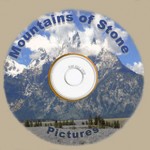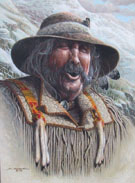Forest Fire Home Page
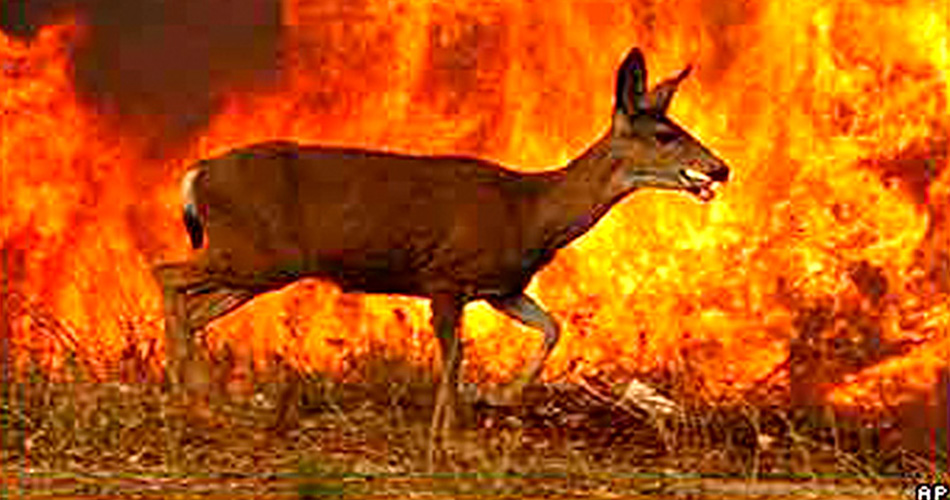
Environmentalist Yellowstone Fire
by
Ned Eddins
Thefurtrapper Article Catagories:
Mountain Men American Indians Exploration
Emigration Trails Forest Fires
Historical Novels: Mountains of Stone The Winds of Change
Related Articles:
Mule (Horse Creek) Fire 2002 Forest Mismanagement
Forest Fire Reader Responses
For a great many people living near Yellowstone National Park, the 1988 Yellowstone fires were an environmental catastrophe. The first of the Yellowstone Park fires started near Enos Lake in the Teton Wilderness Area. The fire was under a thousand acres for the first week while the forrest service was deciding whether to put it out or not. Once the fire took off and with no hope of controlling it, one of the excuses given by Yellowstone National Park Superintendent Barby was no one could predict how dry the forest was. If Park Rangers had gotten out of their pickups and led a string of packhorses across the Pacific Creek meadows, as we did two days before the fire started, they would have known how dry it was from the dusty trail.
Prevailing drought resulting in abnormally low tree moisture, accumulation of dead trees, heavy areas of downed timber, and the environmentalist let burn policy set the stage for the Yellowstone National Park forest fire disaster. These factors should have been obvious to the personnel charged with protecting our oldest National Park.
In regards to the Yellowstone National Park forest fires, Monica Turner, landscape ecologist at the University of Wisconsin-Madison concludes,
Big fires are not detrimental to the system in any way. It’s difficult for the human-wild land interaction, but from the perspective of plants and animals, fire is a normal event, well within their capacity to deal with.
Dr. Turner and other proponents of letting natural fires burn are right, but fail to mention in heavy forested areas, the fire burns so hot it basically sterilizes the soil, killing the burrowing animals as well as the insects. Since nothing can live in these “sterilized areas”, the only way it can regenerate is by wind-spread seeds, which can take years as some of the following pictures will show.
In the grand scheme of an ecological system, big fires may not be detrimental, but they are devastating to many of us. A few years ago (1997), I rode through areas of a “dead sterile forest” below the head of the Yellowstone River. The blackened snags, and a total lack of birds, small mammals, and insect sounds produced an eerie, sad feeling as you rode along the trail.
The following excerpt from an article by the Greater Yellowstone Coalition is representative of the misleading hype a majority of the environmental websites on the 1988 Yellowstone National Park forest fires are putting out.
Fourteen years later, Yellowstone forests are healthy, green, and growing. Woodlands charred in ’88 are being replaced by robust conifer under stories. The 1990s were a period of renewal for Yellowstone, and visitors today are fascinated by post-fire regret. With the return of nutrients to the soil, lush grasses and forbs benefit wildlife, new aspen growth offers diversity, while burned snags provide increased nesting habitat for birds. Wildflowers are profuse and regeneration has been prolific http://www.greateryellowstone.org/lands/wildland-fires/fires.html. [This link no longer works. It would be interesting to know if the people at the Coalition have changed their minds on this prolific regeneration].
What irked me the most about this Greater Yellowstone Coalition post is that it was quoted by a New York newspaper. The article writer’s conclusion was if the forest regenerates in fourteen years why worry about forest fires?
The next two forest fire pictures show an entirely different picture of the damage done by the Yellowstone National Park forest fires of 1988. These pictures of burned areas from the Yellowstone Park forest fires were taken from the road between the South Entrance of Yellowstone National Park and Lewis Lake at the end of June 2002.
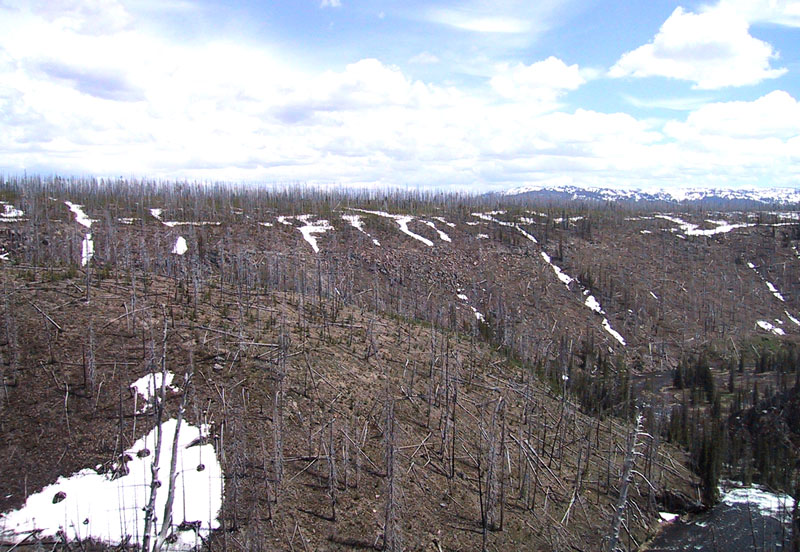
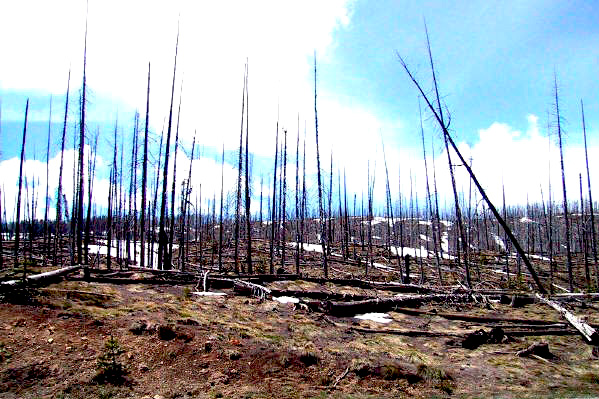 Highway 89 between South Entrance and Lewis Falls – 2002
Highway 89 between South Entrance and Lewis Falls – 2002
After fourteen years, there is little growth of new trees and certainly no bird nests, or anything else along this section of the highway. The Greater Yellowstone Coalition description of re-growth makes you wonder if anyone from the Yellowstone Coalition has even seen Yellowstone.
Twenty-four years after the Yellowstone fire, an interesting article on the slow rate of recovery (1988 to 2011) of the 1988 Yellowstone National Park Fire was put out on this web site, http://earthobservatory.nasa.gov.
…In the years that follow, the burn scar fades progressively. On the ground, grasses and wildflowers sprung up from the ashes. Over time, tiny pine trees took root and began to grow. The new trees grow more quickly (photosynthesize at a faster rate) than older, mature forests. Because they use and reflect sunlight differently than older forests, the new trees are lighter in color in these images. Fingers of new forest are most evident intruding into the narrow strip of burned land on the right edge of the image. Forests are likely returning elsewhere as well, but the small trees do not produce a dense enough canopy to show up well in the image. Some of the other changes seen from year to year are seasonal differences; the images range from July to October.
…Though changes did occur between 1988 and 2011, recovery has been slow. In 2011, the burned area is still clearly discernible, though much of the eastern (right) portion of the image is covered once again by trees and vegetation. The high-elevation plateau has a short growing season, with hot, dry summers and cold, harsh winters. In such an environment, it will take decades [over a hundred years at this altitude] for the forest to reach its former state.
Opposition to forest floor clean up, any type of clear cuts, and the let burn policies of the Sierra Club and other radical environmentalist groups are destroying our National Forests. Forest Service environmentalist and bureaucratic policies have rendered federal agencies ineffective in managing our wildland (all land under federal agencies). National forests in the West are in deplorable condition, and the advocacy of letting natural fires burn, or in some cases to correct decades of fire-fuel buildup with poorly managed prescribed burns, is destroying our forestlands. Examples of the catastrophic damage done to our National Parks and National Forests from advocating these environmental policies are the Yellowstone National Park forest fires of 1988, the Mesa Verde forest fire of 2000, both of which were caused by lightning, and the prescribed burn resulting in the Cerro Grande forest fire near Los Alamos, New Mexico in 2000. And now, there is the Colorado Hayman Fire and the Oregon Biscuit Fire of 2002 followed by the California Forest Fires of 2003 and 2004.
As long as some environmental and conservation groups fight every change in forest management policy or cleanup efforts this pattern will continue…as an example, three environmental groups have filed lawsuits to prevent removal of burned trees from the Oregon Biscuit Fire area.
The Internet is full of articles justifying the environmentalist’s position on the Yellowstone National Park forest fires of 1988, as well as, other natural or lightning caused forest fires. Most of these sites paint a picture of Yellowstone National Park as being more beautiful than ever, and what a wonderful thing it was, and is, to observe nature at work in the Yellowstone National Park ecosystem. In vast areas of Yellowstone, the destruction caused by the Yellowstone National Park forest fires of 1988 is nearly as visible today as in 1988. The forest fire devastation in the heavy-timbered areas of Yellowstone National Park will be present for generations. Complete regeneration from a forest fire at this altitude in the Rocky Mountains takes from one hundred to one hundred and twenty years.
You cannot fault environmentalist groups for their ideals, but they are completely misguided and often totally misleading with their rhetoric. In trying to protect the forests, they are destroying them. There is no question within a few years meadows and other open areas come back better than before, but not thick-timbered areas.
Here is the same scenario from the Mesa Verde fire of 2000. The Mesa Verde fire pictures were taken in May 2003 from the highway near the Cliff Palace dwelling.
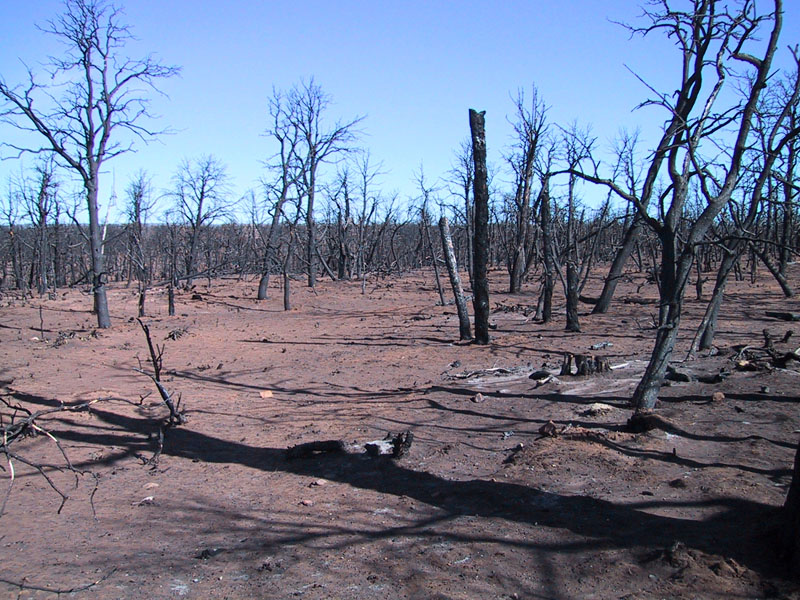
Except in a few places around buildings, little to no effort is being made by the park service to clean up this downfall along the road.
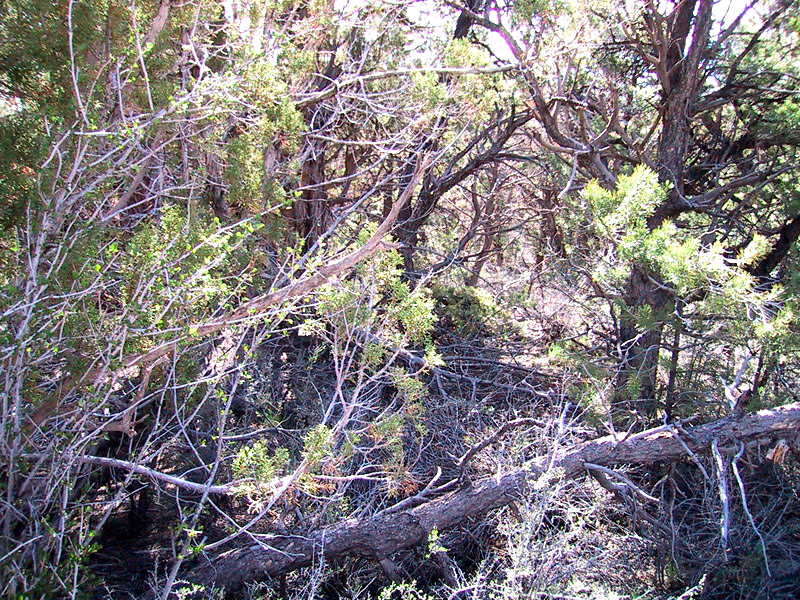
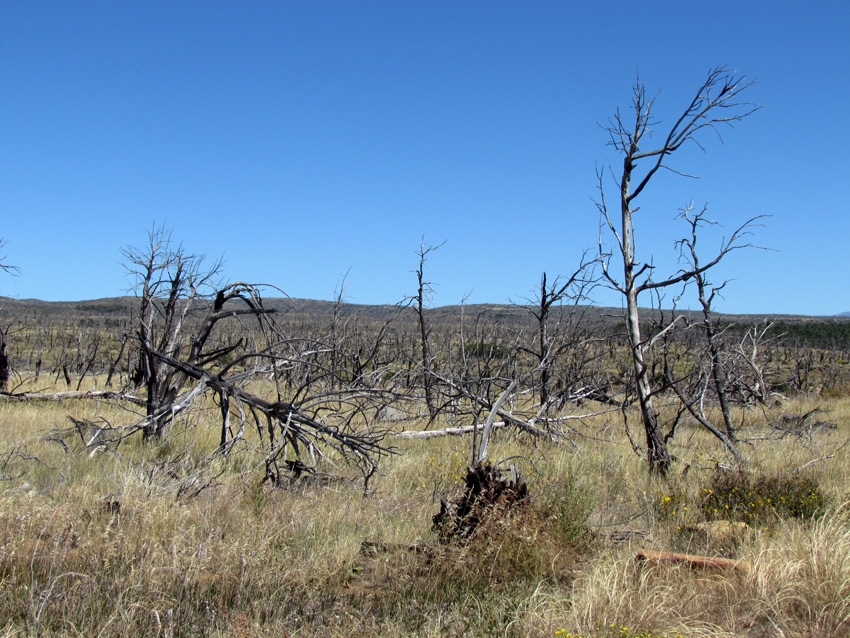
The junipers on the sides and in the background are more fire resistance than the pines.
Prescribed Burns:
If not properly handled, for example checking projected wind conditions, prescribed burns can wreak havoc as did the Cerro Grande prescribed burn resulting in the Los Alamos forest fire of 2000. The finger pointing, in regards to the responsibility for the Los Alamos prescribed burn getting out of control, is still going on two years later. The big argument now is did the prescribed burn cause the problem, or was it a backfire set to control the prescribed burn. What difference does it make? The end result was the Los Alamos forest fire burned over 47,000 acres, destroyed 235 homes, and endangered the Los Alamos National Laboratory with its nuclear weapons. After decades of poor or no forest management due to bureaucratic policies and pressure from environmentalists, prescribed burns must be handled with extreme caution. The ridiculous part is after spending years of submitting paper work and possibly fighting lawsuits to do a prescribed burn, several fires have gotten out of hand because the Forest Service or Bureau of Land Management personnel ignited the fire without checking projected wind conditions.
The primary goal of all federal agencies should be the prevention of forest fires, however, under the right conditions, i.e. controllability and weather, the use of prescribed burns can be an effective method for cleaning up areas of downfall on the forest floor.
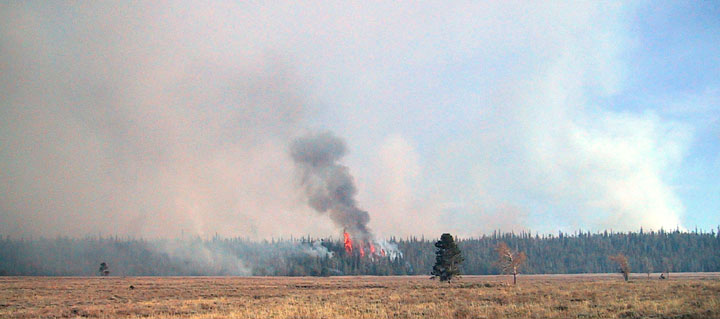
This Timber Island fire picture is a good example of a beneficial prescribed burn. The prescribed burn was confined to small patches of dense timber on the north end of a conifer island. With favorable weather conditions and being isolated from other stands of timber by a sagebrush flat, there was minimal danger of this prescribed-burn fire escaping to other areas. This picture of a prescribed burn was taken in Grand Teton National Park on October 19, 2002…the paper work initiating the studies required for approval to carry out this prescribed burn were started in 1997.
Not all forest fires need to be put out. If in the right area and closely monitored, many fires do more good than damage. A good example of this is the 2002 Blacktail Butte fire in Grand Teton National Park.
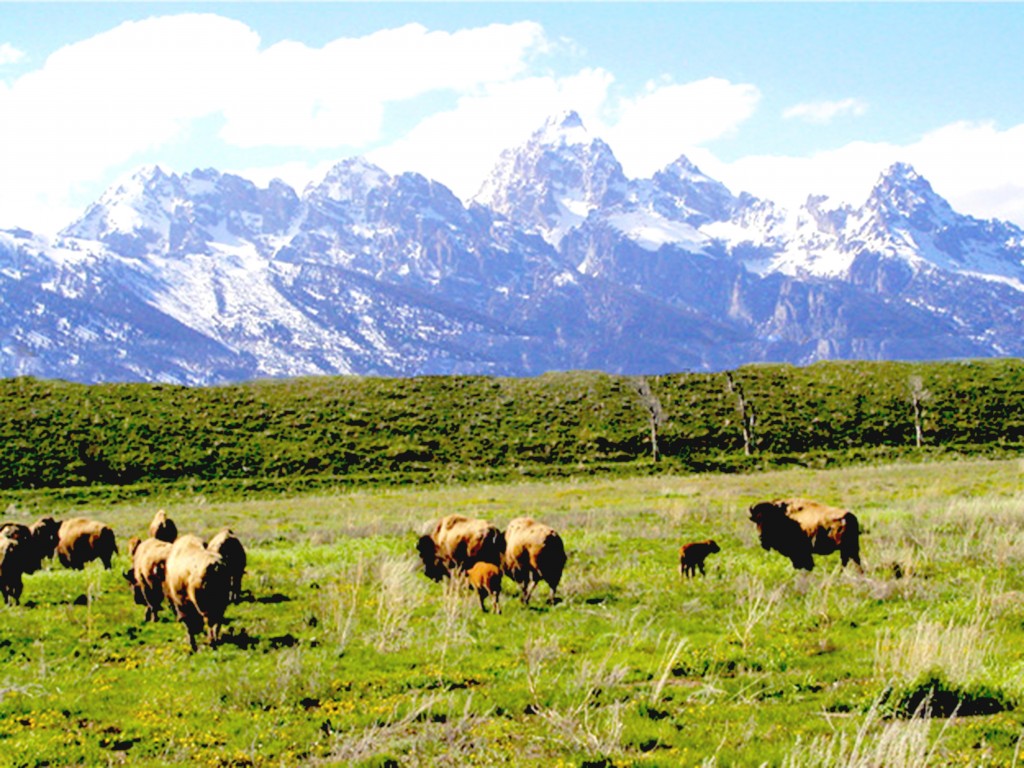
Buffalo started feeding on the mineral-rich sagebrush flat south of Blacktail Butte the next spring, whereas before the fire, you seldom saw buffalo in this area.
Why is the West burning?
The National Environmental Protection Act provides radical environmentalist groups with a means of filing lawsuits against wildland agency personnel if their decisions do not follow a myriad of bureaucratic guidelines. In order to protect themselves from lawsuits, various specialists are required to make sure the supervisory personnel’s decisions meet all of these guidelines. This has created a situation where it may take years of study to make a simple decision. In terms of the forest service, a large portion of its budget is spent on paper work, and lawsuits…not on forest management.
Environmentalist pressures, sporadic forest fire suppression policies, build up of dead trees, both standing and down, urban sprawl, mountain retreats, housing developments next to, or surrounded by, national forests, basically nonexistent logging in national forests, etc. have created an environment in which forest fires are difficult, if not impossible, to control.
The following forest fire stats from the Wildland Fire Statistics reveal the total cost of fighting fires on our national wildland in the year 2000 was $1,362,367,000 dollars…ten percent higher than the previous three years combined. From 1988 to 2001, environmentalist-fostered policies resulted in an eight percent increase in wildland fires over the previous fourteen years. During the ten years from 1988 to 1997, eighty-eight percent of wildfires were attributed to human causes and twelve percent to lightning. However, these lightning caused “natural fires” accounted for fifty-two percent of the total acres burned…twelve percent of the fires resulted in fifty-two percent of the acres burned, and it gets worse. In 2001, lightning caused fifty-nine percent of the fires and accounted for eighty-two percent of the acres burned, www.nifc.gov/fire_info/nfn.htm And now, the major efforts of fire suppression are directed towards saving buildings, not the forests.
The primary cause of forest fires burning out of control is the build up of down timber, and yet, other than with the use of prescribed burns, environmentalists oppose any attempt at forest cleanup.
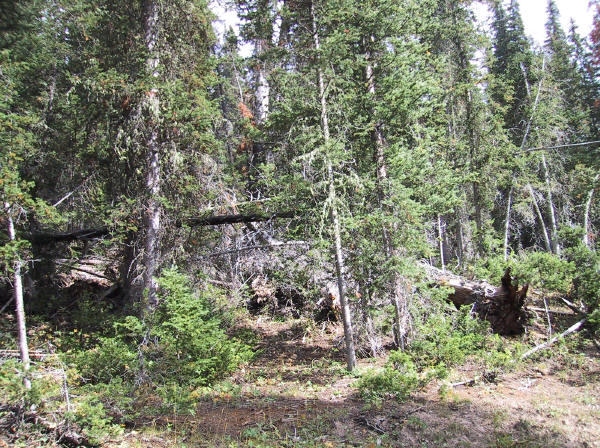
With our wildland burning up, the environmentalists cry is, if the fire is from natural causes it should be allowed to burn, but Thomas M. Bonnicksen a professor of Forest Science at Texas A&M University disagrees.
In a historic forest, gentle fires burned often enough to clear dead wood and small trees from under the big trees. They might flare up in a pile of logs or a patch of thick trees, but would quickly drop back to the ground. Such hot spots kept forests diverse by creating openings where young trees and shrubs could grow.
This picture clearly shows the value of clear cuts in forest fire management. The fire burned up to the clear cut area and stopped.
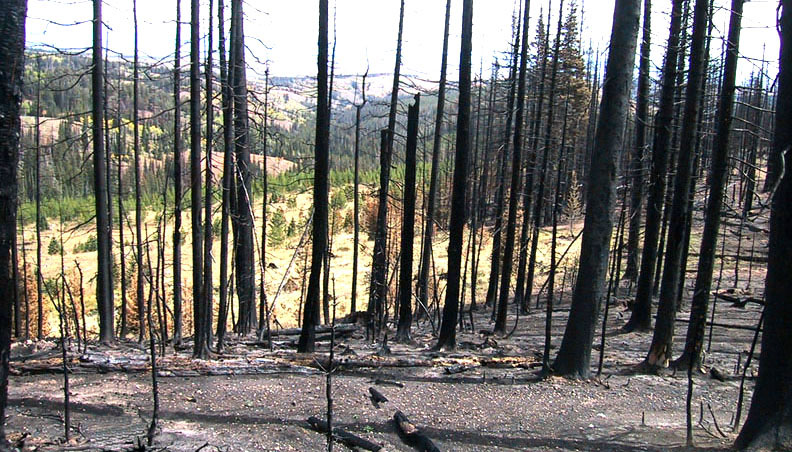
Until observing the effectiveness of a clear cut strip in stopping a forest fire, I would have agreed clear cut forest areas are bad, and still do, if the clear cut is a whole mountainside. However one-fourth to one-half mile wide clear-cut bands are beneficial to the forest and to wildlife. These clear-cut bands are the single most effective means of stopping a forest fire. Within a year after being clear cut, these clear cut areas have newly planted trees, grasses, abundant flowers, and are full of game signs. For several years after a ground-sterilizing forest fire there is nothing but black ground. Proper forest management includes letting some fires burn, prescribed burns, and areas of strip clear cuts. These management practices increases the habitat for all types of wildlife, whereas hot burning forest fires sterilizes the soil and nothing grows, or lives there, for many years.
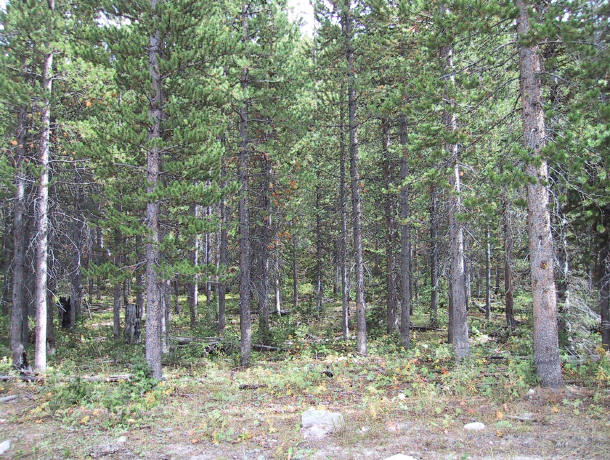
The Sierra Club and other environmentalists say deliberately set fires are the best way to solve today’s wildfire crisis, but each 20,000-acres of “prescribed burn” is likely to produce one escaped fire. Their simplistic reasoning: fire is natural and therefore good for forests. Yet, ironically, the Sierra Club also has a “zero cut” policy. It wants to protect trees from loggers, but it does not mind killing millions of trees with fire, www.nationalcenter.org.
Replies to the forest fire article give various perspectives on forests fires, and are well worth reading. There have been some excellent replies both pro and con.
The Forest Fire article was written by Ned Eddins of Afton, Wyoming.
Permission is given for material from this site to be used for school research papers.
Citation: Eddins, Ned. (article name) Thefurtrapper.com. Afton, Wyoming. 2002.
This site is maintained through the sale of my two historical novels. There are no banner adds, no pop up adds, or other advertising, except my books — To keep the site this way, your support is appreciated.
Mountains of Stone Winds of Change
There have been many requests for copies of pictures from the website. The best website pictures, and others from Jackson Hole, Yellowstone, and Star Valley, Wyoming, have been put on a CD. The pictures make beautiful screensavers, or can be used as a slide show in Windows XP. When ordering Mountains of Stone, request the CD and I will send it free with the book. The Winds of Change CD contains different pictures than those on the Mountains of Stone CD. To view a representative sample of the pictures on the CDs, click on…
To email a comment, a question, or a suggestion click on Mountain Man.
To return to the forest fire home page click on the Elk logo.

Forest Fire Responses Mule Fire 2002 Forest Mismanagement

